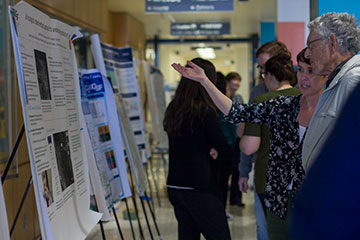
Jeroen Roose, PhD is interested in genetic lesions that lead to abnormal Ras signal transduction events and development of diseases such as autoimmunity and cancer. Photo by Maurice Ramirez
Successful cancer centers like the HDFCCC place a premium on interdisciplinary collaboration. With labs, clinics and offices spread among three UCSF campuses, leadership and members continually devise ways to overcome the geographic separation. Jeroen Roose, co-leads the Parnassus Cancer Research Steering Committee and worked with colleagues to established a research symposia series there. Below, Roose shares his thoughts on the X factor in successful research, collaborating with colleagues anywhere, and work happening in his lab.
Q. How does the Parnassus Cancer Research fit in with the other initiatives ongoing at Parnassus?
It is a very interesting time for Parnassus as we are collectively defining the future shape of the academic enterprise. The spirit amongst faculty at Parnassus has always been collaborative, and this has led to the formation of Focal Programs. One of these Focal Programs is ImmunoX that I helped develop. The X in ImmunoX stands for all the connections that Immunology has with other disciplines. These Focal Programs are programs that house investigators from different departments and divisions. There are several other new and existing ones under development (e.g. Aging Research Institute and the Diabetes Institute). My colleagues and I hope that Parnassus cancer research grows to one of these Focal Programs - with emphasis on the X for collaborating.
Q. What resources exist at Parnassus that members at other campuses might not know about or are underutilized?
There are several exciting new opportunities. For example, the BIDC has a Lattice Light Sheet microscope; and in the Parnassus flow core there are two CyTOF machines. Most recent, is the initiative of the CoLabs to house many of these core facilities in a new, contiguous space at Parnassus. My lab is spearheading an Organoid Core effort that will be part of the Disease to Biology (D2B) unit of the CoLabs. These Colabs will definitely enhance the X in research at UCSF. For example, I’m thinking about the interface between clinical and basic science.
Q. The new Parnassus Cancer Research Symposia have been well attended. What motivated you to organize these?

The Parnassus Symposia feature lectures and a poster session. The next Symposium is scheduled for September 7th.
Indeed, they have been great so far. With commitment from leadership and the generous gift from the Diller family toward a new medical center at Parnassus Heights, it became clear that the academic programs based there are going to play an important role in the future. So, some cancer research colleagues and I brainstormed how we could convey a stronger identity for work done at Parnassus. We discussed with Alan Ashworth and Amanda Sibley how we could stimulate and deepen collaborations with HDFCCC researchers at all campuses. These new Parnassus Cancer Research Symposia are a first step toward accomplishing these goals. Val Weaver, PhD, director, Center for Bioengineering and Tissue Regeneration, is organizing the next one on September 7th.
Q. How do members of the Parnassus research community connect with researchers from other campuses?
I believe that the open, relaxed atmosphere is very special at UCSF. This did not go unnoticed by outside speakers, such as by Hans Clevers and Mina Bissell, who presented at the January symposium.The different seminar series at all the campuses provide excellent opportunities to connect. Andrei Goga recently launched a CC&I (Cell Biology, Cancer, and Immunology) RIPS at Parnassus. Also, the Preclinical Therapeutics Core was invited to present at one of these, exposing the Parnassus research community to the PTC at Mission Bay. And education at UCSF, of course, plays a role. The graduate programs and the students strongly enhance the cohesiveness between campuses. We all serve on one another’s student thesis committees, and I love it how collaborations sprout from these. Naturally, we can always do better. At Parnassus, we are aiming for some modern virtual presence rooms to further stimulate cross-pollination between the campuses.
Q. Talk to us about a project that represents cross-campus collaboration?
Part of my lab works on leukemia, and we have had long-standing collaborations with Kevin Shannon, MD, and Mignon Loh, MD. We focus on untangling oncogenic signaling networks in the leukemia space, using synthetic lethality screens and CyTOF. This is very much in the realm of precision medicine, and I am eager to continue our collaboration to try to translate our fundamental research to opportunities in the clinic. With that in mind, I am very excited about the new Precision Cancer Medicine Building (PCMB) at Mission Bay.
Q. Talk about the interests of your lab and which research disciplines are involved
When I started my lab at UCSF in 2007, I decided to expand our signaling and cell biological studies on T cells to cancer, such as leukemia but also carcinomas. The latter moved us to the field of epithelial stem- and progenitor- cells, and for a while I think my team members felt somewhat lost. But now with the whole surge of cancer-immunotherapy, borders between disciplines have faded, which I find very exciting. It brings us back to the X in research, and I think many of us at UCSF are treasuring and searching for these wonderful collaborations between different groups. The X is so much more than the sum of the individual components.
Q. How do you think that cultivating a cancer-research community at Parnassus will help campus-wide coordination/cohesion?
My colleagues and I will work hard to make Parnassus cancer research a success, especially to promote the campus-wide cohesion and enhance the synergy within the HDFCCC. Multiple exciting cancer research programs across different UCSF campuses should be seen as a strength. We can make important collective impacts on cancer discovery and patient therapies when we capitalize on the collaborative spirit at UCSF.